
Billing and cooing
April 29th, 2012
I've always found female Wood Ducks have a gentle, contented look about them. This one looked especially contented as her mate preened her head to toe.
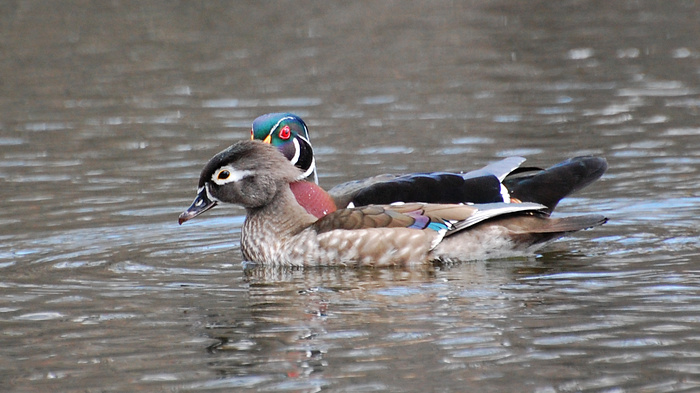
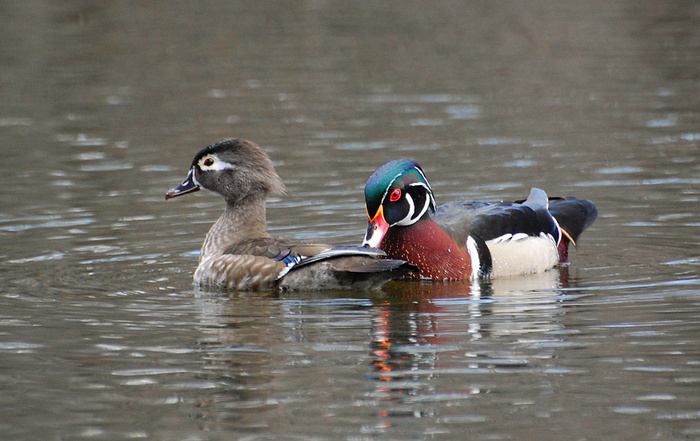
Ethics of recorded bird calls
May 1st, 2012
I found this article to be a very informative guide on the ethics of bird call playback. I'm heartened to hear that no research has shown damage to breeding bird populations. My fear, that I might accidentally convince a bird to give up and desert its nesting grounds, appears unfounded. It seems that the worst that can happen is a breeding male can "lose face" with his neighbors and/or mate--and only in the case of aggressive (loud and prolonged) playback, where they will perceive him as the loser and the phantom rival as the winner.
Contrast
May 3rd, 2012
A study in contrast of a Black-Capped Chickadee, red osier dogwood, and blue sky. This is an old photo that I don't think I've shared before.

1680x1050 wallpaper
The spring warbler paparazzi
May 6th, 2012
This Black-Throated Blue Warbler attracted quite the throng of nature photographers when he came down low in the branches at Mud Lake. It's an uncommon bird to see even in migration, and arguably, among the handsomest of warblers. I joined the paparazzi and managed to get one good shot through a small opening in the foliage.
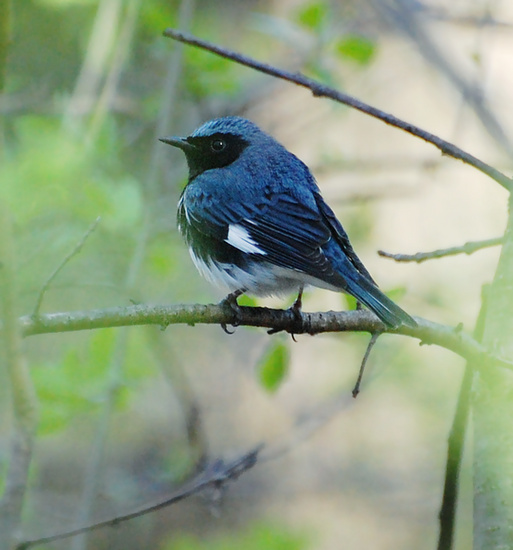
Palm Warblers are common migrants here, but rare breeders. Their favorite habitat is sphagnum bog, such as Mer Bleue, and that is in fact the only place in Ottawa to find them in summer.
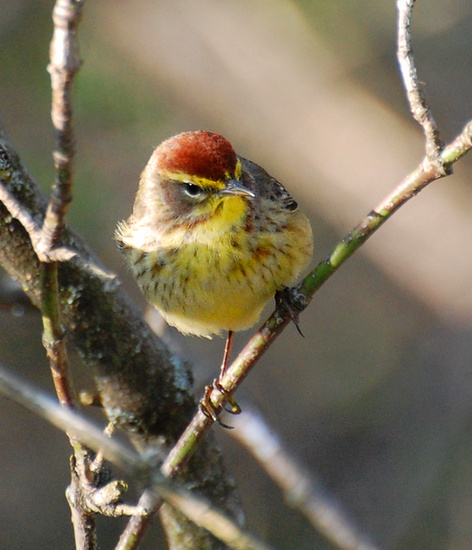
Ottawa birding is blowing my mind. I've never seen a spring like this. All of a sudden the land is exploding with birds--much the way it's exploding with color! I've seen and/or heard twenty new species between yesterday and today, including eight new warblers.
I also saw my first dragonflies, my first Black Swallowtail, my first ladybugs (eensy weensy ones crawling around on a dandelion), and got my first mosquito bite :-)
Drama at the Nortel wetland
May 18th, 2012
Yesterday in the Nortel woods, I was walking along where some stones traverse a wet spot on the path, and heard a Sedge Wren singing. Sedge Wren is a small, shy and secretive bird, rare in Ottawa. It would be a lifer for me, so I spent some time trying to spot it, without success.
At some point, I saw one bird chase another out of the area. The chaser was a Common Yellowthroat. I couldn't tell who the chasee was, but after this occurrence, I didn't hear the wren sing again.
Today I went back armed with my IPod, and attempted to call the wren out (if it was still around) by playing its song. It never responded. I did get a response though--a big one! Common Yellowthroats in the area became agitated. They're normally skulkers (though not as secretive as Sedge Wrens) in thick vegetation, but as soon as I started playing that song, I had multiple yellowthroats popping up into the trees in plain view, looking around, scolding, and then singing at the top of their voices. I got some of the same reaction from nearby Swamp Sparrows.
One thing some people don't realize is that, while birdsong sounds cheerful to us, it's actually somewhat aggressive. It's an expression of self-assertion and fitness: "this is my territory and I've got what it takes to defend it." (Think of how much energy it takes to sing all day, as some birds do. Or how much guts it takes to do something that draws attention to yourself when you're a small bird surrounded by potential predators.) So the beautiful golden-throated bird popping into a tree and singing a bright, happy-sounding "witchety witchety witchety!" was the avian equivalent of a man flexing his biceps and saying, "oh yeah? Well check this out." (I even noticed an increase in general skirmishes, none of them involving wrens: birds chasing each other around, and such. It had the feel of a bar brawl. "Who, me? I didn't say it!") In fact studies have shown that birds' testosterone levels skyrocket when they hear the song of another of their species in their territory.
But this was a case of cross-species aggression, and, together with yesterday's event, suggested that Yellowthroats consider Sedge Wrens to be direct competitors. It made me wonder: could it be one of the reasons Sedge Wren is so secretive, uncommon and local (breeding in certain places one year and then gone the next) is because it can't stand up to other birds who share its habitat (sedge marshes and wet meadows)? It's 4 and a half inches long, which is smaller than most. Just an off-the-cuff theory.
The Wikipedia page gives me an idea of why a Sedge Wren might not be such a popular neighbor. It says, "he may puncture the eggs of other birds nesting nearby"!
Pink Ladyslippers
May 25th, 2012

I still remember the day, as a child, I found one lone pink ladyslipper growing in the woods behind my house. It seemed rare and special to me even then. That was before I knew why they're so uncommon. They require acidic soil, they're slow to develop, and if picked, they will not regrow. Most interestingly, ladyslippers can't sprout without the help of a symbiotic fungus. Their seeds are tiny and bear no food supply for the developing plant. The fungus penetrates the seed and nourishes it. Payback comes later when the fungus extracts nutrients from the roots of the mature plant.
Until recently, Mer Bleue bog was the only place I knew in Ottawa to find this flower. I've since discovered that the South March Conservation Forest (a wonderful natural area near our new home) has them in abundance!
A Gift
May 29th, 2012
Black-Billed Cuckoos are shy, elusive birds. In five years of enthusiastic birding, I'd only ever seen one once--and I only saw him because my birding companion played a recorded call, convincing him that a rival male was in his territory.
Until today! I was hiking Greenbelt Pathway West when this fellow came right out in the open. He had apparently found an oak tree full of food (perhaps caterpillars--cuckoos have a voracious appetite for them), and was too caught up in his feeding frenzy to bother hiding from me.

It really felt like a gift from the universe.
Katydid nymph on hawkweed
May 31st, 2012
I'm sure insectophobes would call this "a good flower spoiled." But I'm rather taken with it.

1680x1050 wallpaper
The sap tapper
June 2nd, 2012
My next two posts come from a leisurely afternoon hike through South March Conservation Forest. I continue to be thrilled at the wildness and biodiversity of these woods, which rival anything I've seen in the Gatineau.

This was the tamest Yellow-Bellied Sapsucker I'd ever found. He didn't fly away as I approached, but continued to tap away at his sap wells while I snapped pictures. Sapsuckers are specialized woodpeckers. Those rows of small holes are his work. He'll lick up any sap that leaks out, as well as any insects that are attracted to it.
Sapsuckers are considered a "keystone species", important to the survival of many other birds and animals, not least hummingbirds. When flower nectar is in short supply in spring, sapsucker-made wells can help tide them over.
Nesting Killdeer at South March
June 4th, 2012
In the east part of South March Conservation Forest is a large beaver pond called Heron Pond. At its north shore is some of the most unique geology I've seen in Ottawa: a vast sandstone barren, dotted with short pine trees, and encrusted with a rich variety of mosses, lichens, grasses and wildflowers. It's been said that the plain dates back to the Paleozoic era. I've seen a pair of nighthawks courting above it: the male flying close to the female, then diving straight down and veering up suddenly with a *whoosh* of his wings (you can hear it from a distance.) Nighthawks are a species in decline and considered At Risk in Canada, and I find this rather significant as that part of the forest is not conservation area: it's owned by a developer and could be lost in the future.
Another species I've found breeding on the sandstone plain--though I doubt any conservationists will take interest is this one--is Killdeer! Killdeer are the most successful plovers in North America, and that's because they're so at ease with the changes humans make to the environment. I've seen them in farmland, equestrian parks, on manicured lawns and in parking lots, but this was the first time I'd seen breeding killdeer in an utterly wild, natural environment...and there was something enchanting about that.
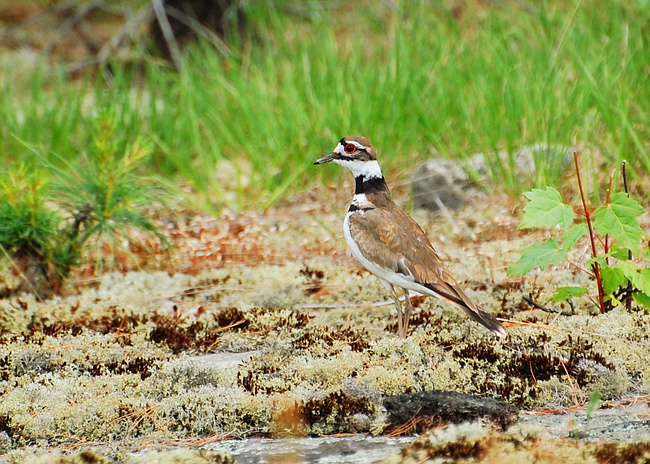
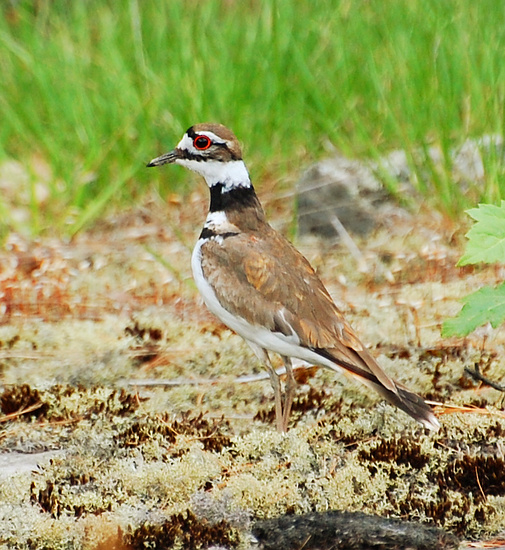
Because killdeer nest on open ground, their eggs and young are vulnerable. So they've evolved means to distract predators away from the nest, generally by acting helpless. If the predator thinks it can easily catch the adult, why bother with the young? It's easy to feel like a louse while pursuing a killdeer for a photo: they cry so pitiably. They sound like they're in such deep distress. One tries to remember that the deep distress is an act. Real distress would be if you got close to their nest--and as long as you follow where they lead, that's sure not to happen.
The crown jewel of the repertoire is the famous broken wing display. The parent killdeer sits down, fans its eye-catching orange tail, sticks its wings out at odd angles, and flops around like a poor, pathetic fish out of water.
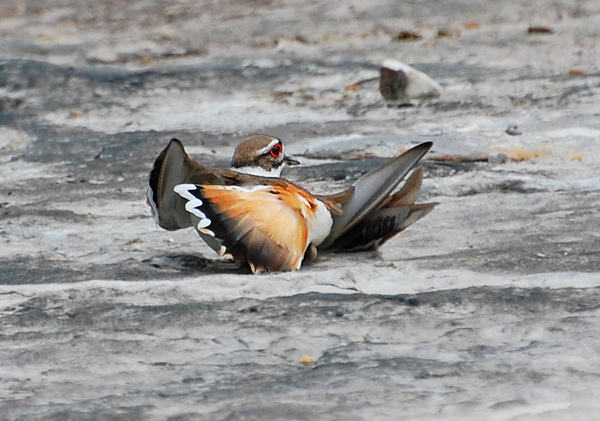
|
